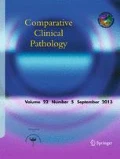Abstract
Recent studies have explained that cancer stem cells (CSCs) can both instigate and maintain tumours. As a result, they are a good choice for targeted therapy in the treatment of aggressive cancers, and their long-term assessment is essential for the follow-up of therapeutic agent efficacy. However, several studies have revealed that their detection on the basis of surface markers is challenging. In this area, there are two main questions. First, why are surface markers of the CSCs so difficult to detect in in vitro studies? Second, are CSCs’ surface markers reliable factors when assessing cancer treatment efficacy? In order to consider these questions, we made three assumptions: (1) CSCs can grow in environmental conditions and in vitro studies, (2) stress exists within in vitro conditions, and (3) isotope diversity in surface markers might lead to problems in reliable identification.
References
Bozorg-Ghalati F, Hedayati M (2015) Relationship between PI3K mutation and sodium-iodide symporter in anaplastic thyroid carcinoma. American J Cancer Sci 4:63–77
Bozorg-Ghalati F, Hedayati M (2016) BRAF mutation and its effects on radioiodine uptake in patients with anaplastic thyroid carcinoma. American J Cancer Sci 5(1):22–33
Bozorg-Ghalati F, Hedayati M, Dianatpour M (2017) CD133 as a biomarker of thyroid cancer stem cells. Int J Curr Res 9(5):51284–51291.
Haghpanah V, Fallah P, Naderi M, Tavakoli R, Soleimani M, Larijani B (2016) Cancer stem-like cell behaviour in anaplastic thyroid cancer: a challenging dilemma. Life Sci 1(146):34–39
He QZ, Luo XZ, Wang K, Zhou Q, Ao H, Yang Y, Li SX, Li Y, Zhu HT, Duan T (2014) Isolation and characterization of cancer stem cells from high-grade serous ovarian carcinomas. Cell Physiol Biochem 33:173–184
Kaiser J (2015) The cancer stem cell gamble. Science 347(6219):226–229
Lathia JD, Mack SC, Mulkearns-Hubert EE, Valentim CL, Rich JN (2015) Cancer stem cells in glioblastoma. Genes Dev 29(12):1203–1217
Liu R, Shen Y, Nan K, Mi B, Wu T, Guo J, Li M, Lv Y, Guo H (2015) Association between expression of cancer stem cell markers and poor differentiation of hepatocellular carcinoma: a meta-analysis (PRISMA). Medicine (Baltimore) 94(31):e1306
Lobo NA, Shimono Y, Qian D, Clarke MF (2007) The biology of cancer stem cells. Annu Rev Cell Dev Biol 23:675–699
Marhaba R, Klingbeil P, Nuebel T, Nazarenko I, Buechler MW, Zoeller M (2008) CD44 and EpCAM: cancer-initiating cell markers. Curr Mol Med 8(8):784–804
McCord AM, Jamal M, Shankavaram UT, Lang FF, Camphausen K, Tofilon PJ (2009) Physiologic oxygen concentration enhances the stem-like properties of CD133+ human glioblastoma cells in vitro. Mol Cancer Res 7:489–497
Norton K-A, Popel AS (2014) An agent-based model of cancer stem cell initiated avascular tumour growth and metastasis: the effect of seeding frequency and location. J R Soc Interface 11:640–743
Plaks V, Kong N, Werb Z (2015) The cancer stem cell niche: how essential is the niche in regulating stemness of tumour cells? Cell Stem Cell 16(3):225–238
Shigdar S, Qiao L, Zhou SF, Xiang D, Wang T, Li Y, Lim LY, Kong L, Li L, Duan W (2013) RNA aptamers targeting cancer stem cell marker CD133. Cancer Lett 330(1):84–95
Waldron NN, Vallera DA (2013) An old idea tackling a new problem: targeted toxins specific for cancer stem cells. Antibodies 2:82–92
Wang L, Huang X, Zheng X, Wang X, Li SH, Zhang L, Yang Z, Xia Z (2013) Enrichment of prostate cancer stem-like cells from human prostate cancer cell lines by culture in serum-free medium and chemo radiotherapy. Int J Biol Sci 9(5):472–479
Yu Y, Flint A, Dvorin EL, Bischoff J (2002) AC133-2, a novel isoform of human AC133 stem cell antigen. J Biol Chem 277(23):20711–20716
Zhang D, Sun B, Zhao B, Ma Y, Ji R, Gu Q, Dong X, Li J, Liu F, Jia X, Leng X, Zhang C, Sun R, Chi J (2014) Twist1 expression induced by sunitinib accelerates tumor cell vasculogenic mimicry by increasing the population of CD133+ cells in triple-negative breast cancer. Mol Cancer 13:207–221
Author information
Authors and Affiliations
Corresponding author
Ethics declarations
Conflict of interest
The authors declare that they have no conflict of interest.
Funding
The assumptions described in this manuscript were extracted from PhD thesis of Farzaneh Bozorg-Ghalati with grant number 6066 that financially supported by Research Institute for Endocrine Sciences, Shahid Beheshti University of Medical Sciences, Tehran, Iran.
Ethical approval
This article does not contain any studies with human participants or animals performed by any of the authors.
Rights and permissions
About this article
Cite this article
Bozorg-Ghalati, F., Hedayati, M. & Dianatpour, M. Are surface markers of cancer stem cells reliable factors for cancer treatment follow-up?. Comp Clin Pathol 26, 981–983 (2017). https://doi.org/10.1007/s00580-017-2504-5
Received:
Accepted:
Published:
Issue Date:
DOI: https://doi.org/10.1007/s00580-017-2504-5

